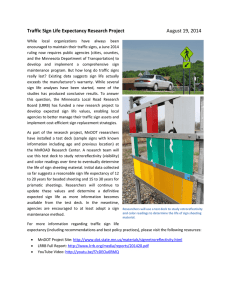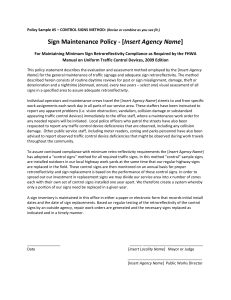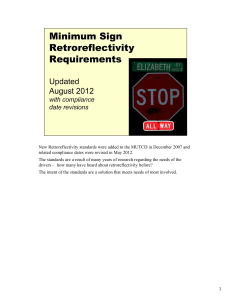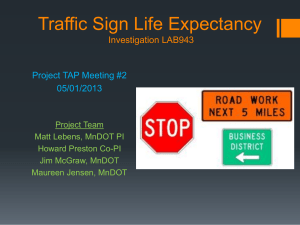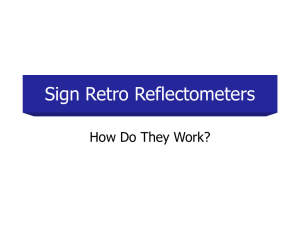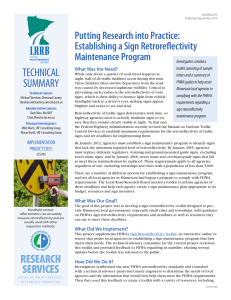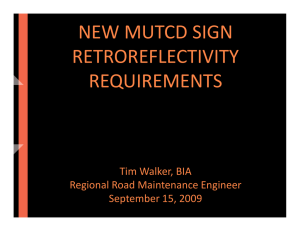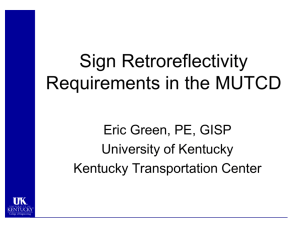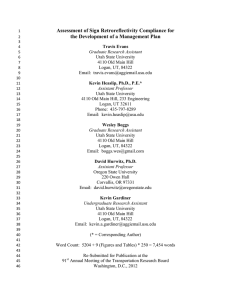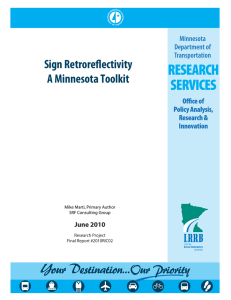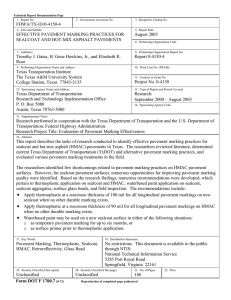Estimating Traffic Sign Life Expectancy What Was the Need?
advertisement
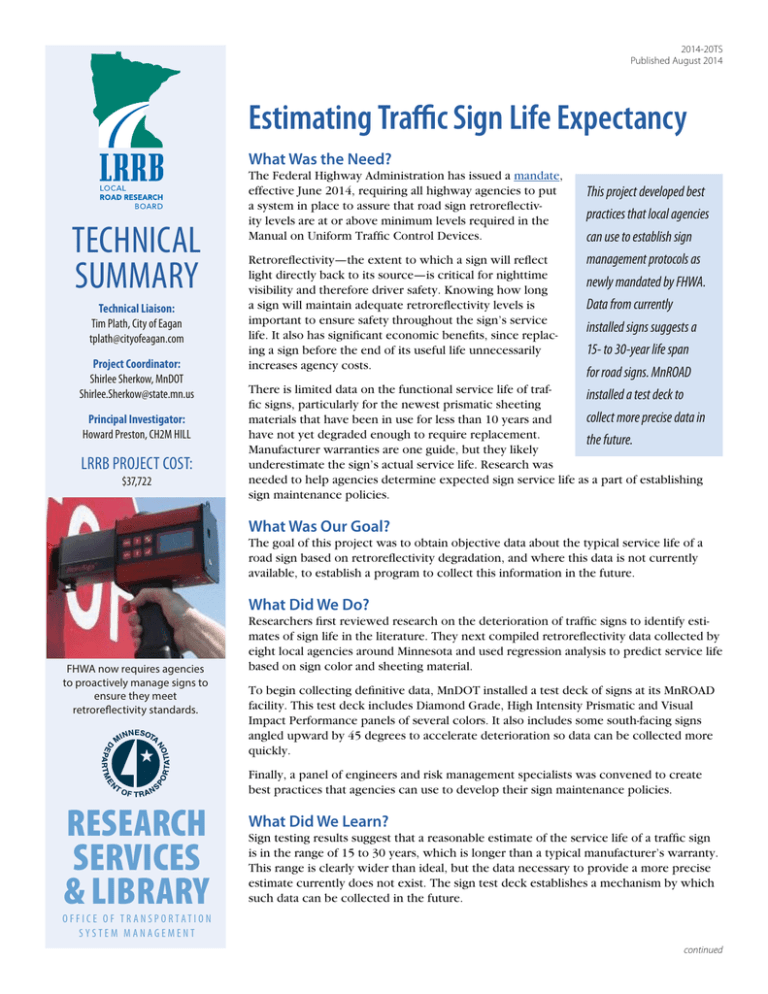
2014-20TS Published August 2014 Estimating Traffic Sign Life Expectancy What Was the Need? TECHNICAL SUMMARY Technical Liaison: Tim Plath, City of Eagan tplath@cityofeagan.com Project Coordinator: Shirlee Sherkow, MnDOT Shirlee.Sherkow@state.mn.us Principal Investigator: Howard Preston, CH2M HILL LRRB PROJECT COST: $37,722 The Federal Highway Administration has issued a mandate, effective June 2014, requiring all highway agencies to put a system in place to assure that road sign retroreflectivity levels are at or above minimum levels required in the Manual on Uniform Traffic Control Devices. Retroreflectivity—the extent to which a sign will reflect light directly back to its source—is critical for nighttime visibility and therefore driver safety. Knowing how long a sign will maintain adequate retroreflectivity levels is important to ensure safety throughout the sign’s service life. It also has significant economic benefits, since replacing a sign before the end of its useful life unnecessarily increases agency costs. This project developed best practices that local agencies can use to establish sign management protocols as newly mandated by FHWA. Data from currently installed signs suggests a 15- to 30-year life span for road signs. MnROAD installed a test deck to collect more precise data in the future. There is limited data on the functional service life of traffic signs, particularly for the newest prismatic sheeting materials that have been in use for less than 10 years and have not yet degraded enough to require replacement. Manufacturer warranties are one guide, but they likely underestimate the sign’s actual service life. Research was needed to help agencies determine expected sign service life as a part of establishing sign maintenance policies. What Was Our Goal? The goal of this project was to obtain objective data about the typical service life of a road sign based on retroreflectivity degradation, and where this data is not currently available, to establish a program to collect this information in the future. What Did We Do? FHWA now requires agencies to proactively manage signs to ensure they meet retroreflectivity standards. Researchers first reviewed research on the deterioration of traffic signs to identify estimates of sign life in the literature. They next compiled retroreflectivity data collected by eight local agencies around Minnesota and used regression analysis to predict service life based on sign color and sheeting material. To begin collecting definitive data, MnDOT installed a test deck of signs at its MnROAD facility. This test deck includes Diamond Grade, High Intensity Prismatic and Visual Impact Performance panels of several colors. It also includes some south-facing signs angled upward by 45 degrees to accelerate deterioration so data can be collected more quickly. Finally, a panel of engineers and risk management specialists was convened to create best practices that agencies can use to develop their sign maintenance policies. RESEARCH SERVICES & LIBRARY What Did We Learn? Sign testing results suggest that a reasonable estimate of the service life of a traffic sign is in the range of 15 to 30 years, which is longer than a typical manufacturer’s warranty. This range is clearly wider than ideal, but the data necessary to provide a more precise estimate currently does not exist. The sign test deck establishes a mechanism by which such data can be collected in the future. O FFICE O F TR ANSP O R TATI O N SYSTEM MANAGEMENT continued “Traffic signs are now considered an asset that agencies are required to proactively manage. The replacement cycle, based on the degradation of the sign’s retroreflectivity, greatly influences sign management costs.” —Howard Preston, Senior Transportation Engineer, CH2M HILL “This work provides information for agencies to use in their sign maintenance policies about how long before a sign’s retroreflectivity drops below a threshold. Those policies are what offer protection against liability.” —Tim Plath, Transportation Engineer, City of Eagan Produced by CTC & Associates for: Minnesota Department of Transportation Research Services & Library MS 330, First Floor 395 John Ireland Blvd. St. Paul, MN 55155-1899 651-366-3780 www.mndot.gov/research The test deck installed at MnROAD includes color and sheeting material combinations and will ultimately provide accurate data about how long it will take for a sign’s retroreflectivity to drop below MUTCD standards. The literature review found several studies of sign life, but none had large enough samples observed for a long enough period to generate valid service life estimates. None of the studies found that sign orientation or weather had a major impact on the deterioration in sign retroreflectivity, although greater variability in observations of south-facing red signs suggests that they may be more susceptible to degradation than other colors and orientations. Minnesota agencies collected 379 valid retroreflectivity readings. No combination of color and sheeting type had more than 100 readings, and very few signs fell below minimum retroreflectivity requirements. Researchers generated trendlines to attempt to predict when signs would likely fall below minimum retroreflectivity levels, but none was based on enough data to be considered conclusive. The project did produce a process for establishing sign management policies as well as sample policy language based on draft policies from entities like the League of Minnesota Cities, Minnesota Association of Townships and counties that have already adopted policies. What’s Next? Signs are considered an asset that agencies must proactively manage. While this research did not give definitive information about sign service life, it provided useful information for local agencies to incorporate into their sign replacement policies to ensure acceptable sign visibility and protect against liability. MnDOT hopes to continue monitoring the test deck until accurate information about service life can be determined. However, monitoring beyond 2016 will require additional funding. Researchers discovered in the course of this project that sign color may fade to unacceptable levels before retroreflectivity degrades. Further investigation of this issue may be warranted. This Technical Summary pertains to the LRRB-produced Report 2014-20, “Traffic Sign Life Expectancy,” published June 2014. The full report can be accessed at http://www.lrrb.org/PDF/201420.pdf.
